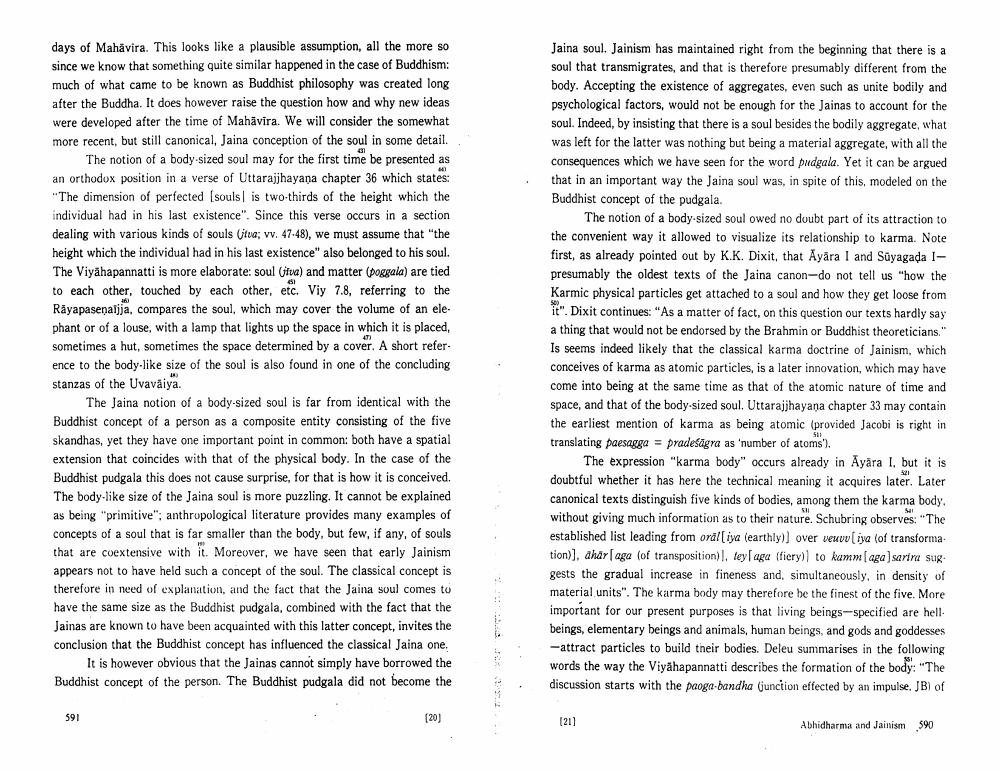________________
days of Mahavira. This looks like a plausible assumption, all the more so since we know that something quite similar happened in the case of Buddhism: much of what came to be known as Buddhist philosophy was created long after the Buddha. It does however raise the question how and why new ideas were developed after the time of Mahavira. We will consider the somewhat more recent, but still canonical, Jaina conception of the soul in some detail.
The notion of a body sized soul may for the first time be presented as an orthodox position in a verse of Uttarajjhayana chapter 36 which states: "The dimension of perfected (souls is two-thirds of the height which the individual had in his last existence". Since this verse occurs in a section dealing with various kinds of souls tva; v. 47-48), we must assume that the height which the individual had in his last existence" also belonged to his soul. The Viyahapannatti is more elaborate: soul Gla) and matter (poggala) are tied to each other, touched by each other, etc. Viy 7.8, referring to the Rayapasenalja, compares the soul, which may cover the volume of an ele. phant or of a louse, with a lamp that lights up the space in which it is placed, sometimes a hut, sometimes the space determined by a cover. A short reference to the body.like size of the soul is also found in one of the concluding stanzas of the Uvavaiya.
The Jaina notion of a body sized soul is far from identical with the Buddhist concept of a person as a composite entity consisting of the five skandhas, yet they have one important point in common: both have a spatial extension that coincides with that of the physical body. In the case of the Buddhist pudgala this does not cause surprise, for that is how it is conceived. The body-like size of the Jaina soul is more puzzling. It cannot be explained as being "primitive": anthropological literature provides many examples of concepts of a soul that is far smaller than the body, but few, if any, of souls that are coextensive with it. Moreover, we have seen that early Jainism appears not to have held such a concept of the soul. The classical concept is therefore in need of explanation, and the fact that the Jaina soul comes to have the same size as the Buddhist pudgala, combined with the fact that the Jainas are known to have been acquainted with this latter concept, invites the conclusion that the Buddhist concept has influenced the classical Jaina one,
It is however obvious that the Jainas cannot simply have borrowed the Buddhist concept of the person. The Buddhist pudgala did not become the
Jaina soul. Jainism has maintained right from the beginning that there is a soul that transmigrates, and that is therefore presumably different from the body. Accepting the existence of aggregates, even such as unite bodily and psychological factors, would not be enough for the Jainas to account for the soul. Indeed, by insisting that there is a soul besides the bodily aggregate, what was left for the latter was nothing but being a material aggregate, with all the consequences which we have seen for the word pudgala. Yet it can be argued that in an important way the Jaina soul was, in spite of this, modeled on the Buddhist concept of the pudgala.
The notion of a body sized soul owed no doubt part of its attraction to the convenient way it allowed to visualize its relationship to karma. Note first, as already pointed out by K.K. Dixit, that Ayara I and Süyagada lpresumably the oldest texts of the Jaina canon-do not tell us "how the Karmic physical particles get attached to a soul and how they get loose from it". Dixit continues: "As a matter of fact, on this question our texts hardly say a thing that would not be endorsed by the Brahmin or Buddhist theoreticians." Is seems indeed likely that the classical karma doctrine of Jainism, which conceives of karma as atomic particles, is a later innovation, which may have come into being at the same time as that of the atomic nature of time and space, and that of the body-sized soul. Uttarajjhayana chapter 33 may contain the earliest mention of karma as being atomic (provided Jacobi is right in translating paesagga = pradesagra as 'number of atoms').
The expression "karma body" occurs already in Ayara I, but it is doubtful whether it has here the technical meaning it acquires later. Later canonical texts distinguish five kinds of bodies, among them the karma body, without giving much information as to their nature. Schubring observes: "The established list leading from ordliya (earthly)] over veuwvliya (of transforma tion)], aharlaga (of transposition), leylaga (fiery)to kamm laga ) sarira sur: gests the gradual increase in fineness and, simultaneously, in density of material units". The karma body may therefore be the finest of the five. More important for our present purposes is that living beings-specified are hell beings, elementary beings and animals, human beings, and gods and goddesses
-attract particles to build their bodies. Deleu summarises in the following words the way the Viyahapannatti describes the formation of the body: "The discussion starts with the paoga-bandha (junction effected by an impulse. JBI of
591
(20)
[21]
Abhidharma and Jainism
590




